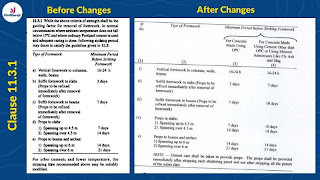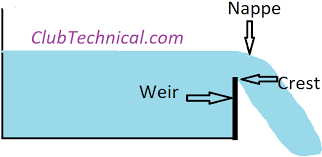IS 456 - 2000 all updates and changes every civil engineer should know
IS
456 - 2000 all updates and changes every civil engineer should know
The Civil Engineering industry's foundation is based on all norms and standards. Civil engineers must know all codes and standards that will be complied with in their field of work. The code and compliances are made to ensure the safety and durability of structures.
Each code holds
its importance, similarly IS 456 - 2000 describes the practice for general
structural use of plain and reinforced concrete. In this blog, we will explore
all updates and changes that every civil engineer should know about IS 456 -
2000.
What
is IS 456 and IS 456 - 2000?
IS 456: The IS
456 was published by the Bureau of Indian Standards (BIS) and describes the
practice of general use of plain and reinforced concrete in India for
construction projects. It is a widely used standard. For the design and
construction of reinforced concrete structures original code IS 456:1978 was
introduced.
IS 456 – 2000:
The IS 456 - 2000 is a revised version of the standard released in July 2000
with important amendments and updates to meet the changing demands and
developments in the field of civil engineering.
Certainly IS 456
– 2000 has seen a lot of changes over time, issued in years Amendment 1 June
2001, Amendment 2 September 2005, Amendment 3 August 2007, Amendment 4 May
2013, and Amendment 5 July 2019 due to certain developments in the industry.
As a civil
engineer, you should know how and what changes have been made over time.
Understanding
Key Clauses in IS 456:2000 (Before and After Amendments)
There are
certain major amendments in important clauses over time, So let's check all
amendments and what were the clauses originally and what were the changes made
in those:
Table No. 2, Page 16 (Grades of Concrete):
The structural
requirements and expected loads on the concrete element determine the choice of
concrete grade therefore table 2 describes different grades of concrete along
with their compressive strength.
Before
Amendment: The 3 grade groups were Ordinary Concrete, Standard
Concrete, and High Concrete Strength.
Where grade
designations were:
Ordinary
Concrete: M10, M15 and M20
Standard
Concrete: M25, M30, M35, M40, M45, M50, M55
High Strength
Concrete: M60, M65, M70, M75, M80
After
Amendment: The change in cement grade has been introduced
where, Previously M60 grade was included under High Strength concrete, but now
it falls under standard concrete.
Whereas, New
grades M85, M90, M95, and M100 under High Strength Concrete have been added.
Before Updates: The 3 grade groups were Ordinary Concrete, Standard Concrete,
and High Concrete Strength.
Revised
grades are as follows:
Ordinary
Concrete: M10, M15 and M20
Standard
Concrete: M25, M30, M35, M40, M45, M50, M55, M60
High Strength
Concrete: M65, M70, M75, M80, M85, M90, M95, and M100
In summary, The
revised version of the table now provides more accurate guidelines for the
selection of the grade of concrete to ensure better structural strength.
Clause
11.3.1, Page No. 25 (Type of Formwork):
The clause describes the criteria of formwork, which is essentially required to shape and support freshly poured concrete until it sets.
Before
Amendment: The previous version of the specifications possibly
were outdated or less comprehensive.
After
Amendment: The table of clause 11.3.1 has been revised where
the Minimum Period Before Striking Formwork has been divided into 2 part: For
Concrete Made Using OPC and other For Concrete Made Using Other than OPC or
Using Mineral Admixtures like Fly Ash and Slag.
Revised line in
clause 11.3.1 last sentence: For lower temperature, the stripping time
recommended above may be suitably modified and new clause 11.3.1.1 has been
added.
Clause 11.3.1
has been revised as: While the above criteria of strength shall be the guiding
factor for removal of formwork, in normal circumstances where ambient
temperature does not fall below 15*C, following striking period may be deem to
satisfy the guideline given in 11.3.
In summary, The
updated version of the clause promotes standard practices to reduce the
possible risk related to formwork due to construction.
Clause 5.1, Page
No. 13 (Material - Cement):
After Amendment:
The changes include the use of Ordinary Portland Cement where clauses 5.1(b)
and (c) have been deleted on page 13. Whereas Clause 5.1(a) has been revised as
" Ordinary Portland Cement conforming to IS 269".
Before
Amendment: The guidelines for the use of Ordinary Portland cement where 5.1(b)
Grade 43 conforming to IS 8112 and 5.1(c) Grade 53 conforming to IS 12269 were
still in use and 5.1(a) was mentioned as "33 Grade ordinary Portland
cement conforming to IS 269". In summary, The updated section focuses on
the importance of using better-quality Ordinary Portland Cement cement for
strong and durable concrete structures, Also the 33 Grade for Ordinary Portland
Cement was mentioned previously.
Clause 5.3
(Aggregates):
Clause 5.3
describes the requirements for aggregates used in concrete mixtures
Before
Amendment: Aggregates shall comply with the requirements of IS 383. As far as
possible preference shall be given to natural aggregates.
After Amendment:
Aggregates shall comply with the requirements of IS 383.
In summary, the
clause focuses on enhancing concrete strength and consistency by defining
accurate aggregate standards.
Clause 5.3.4:
The clause
refers to certain criteria and tests for aggregates to ensure that aggregates
are suitable for use in concrete production.
Before
Amendment: Coarse and fine aggregate shall be batched separately. All-
in-aggregate may be used only where specifically permitted by the engineer-in-charge.
After Amendment:
Coarse and fine aggregate shall be batched separately.
In summary, the
updated version of the clause focuses on the quality assessment of aggregates
for making high-quality concrete mixes
Clause 5.4
(Water):
Clause 5.4
specifies the quality of water to be used for concrete mixtures.
Before
Amendment: Water used for mixing and curing shall be clean and free from
injurious amounts of oils, acids, alkalis, salts, sugar, organic materials, or
other substances that may be deleterious to concrete or steel.
After Amendment:
Water, natural or treated, used for mixing and curing shall be clean and free
from injurious amounts of oils, acids, alkalis, salts, sugar, organic
materials, or other substances that may be deleterious to concrete or steel.
In summary, To
prevent the potential negative impact on material quality, clause 5.4 focuses
on using clean water while making concrete mixtures.
Clause 5.4.3
(Seawater):
The clause
focuses on the use of seawater in concrete, considering its properties and
potential impact on concrete efficiency.
Before
Amendment: Mixing or curing concrete with seawater is not recommended because
of the presence of harmful salts in seawater. Under unavoidable circumstances,
seawater may be used for mixing or curing in plain concrete with no embedded
steel after having given due consideration to possible disadvantages and
precautions including the use of an appropriate cement system.
After Amendment:
Seawater shall not be used for mixing or curing concrete because of the
presence of harmful salts. Under unavoidable circumstances, seawater may be
used for mixing or curing in plain concrete with no embedded steel after having
given due consideration to possible disadvantages and precautions including the
use of an appropriate cement system., In Summary, The updated clause focuses on
the careful and safe use of seawater in concrete in certain circumstances,
Considering its salt component and its possible impact on the durability of
content.
Conclusion:
The IS 456 -
2000 is a foundation that gives detailed requirements and guidelines to ensure
safe, durable, and strong structures. The IS codes indeed are provided by BIS
to ensure safe and sound construction while maintaining its quality considering
a quickly evolving environment.
By adopting the
updated IS 456 - 200 in construction projects, civil engineers can provide
high-quality construction and excellence.
Note: It is
difficult to point out all the changes in the blog, The blog is made to
understand the major changes.
Therefore refer
to the document attached and compare before amendment in 456:2000 , after
amendment and after amendment table no.
2 learn all the changes and revisions made in IS 456:2000.





Comments
Post a Comment